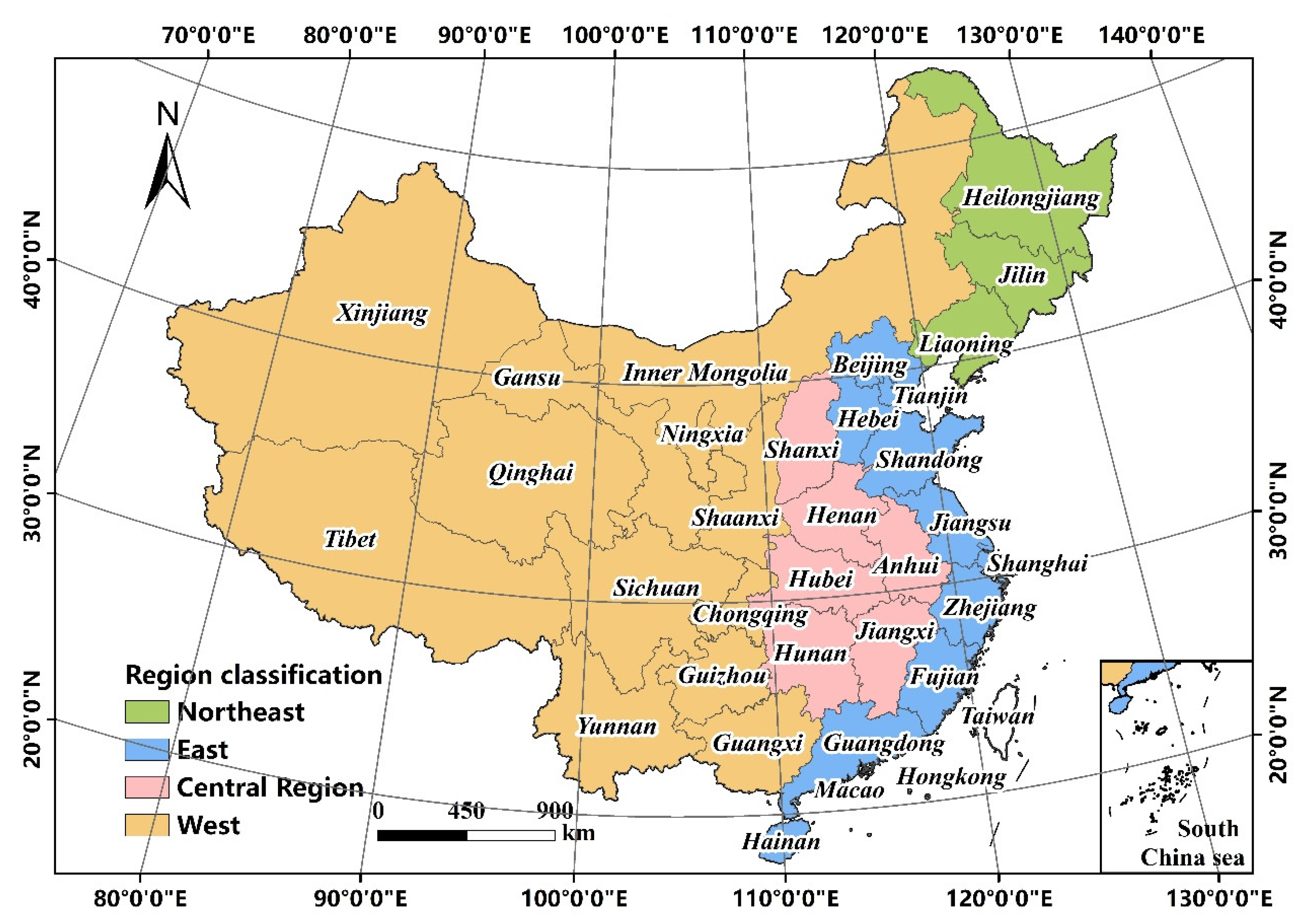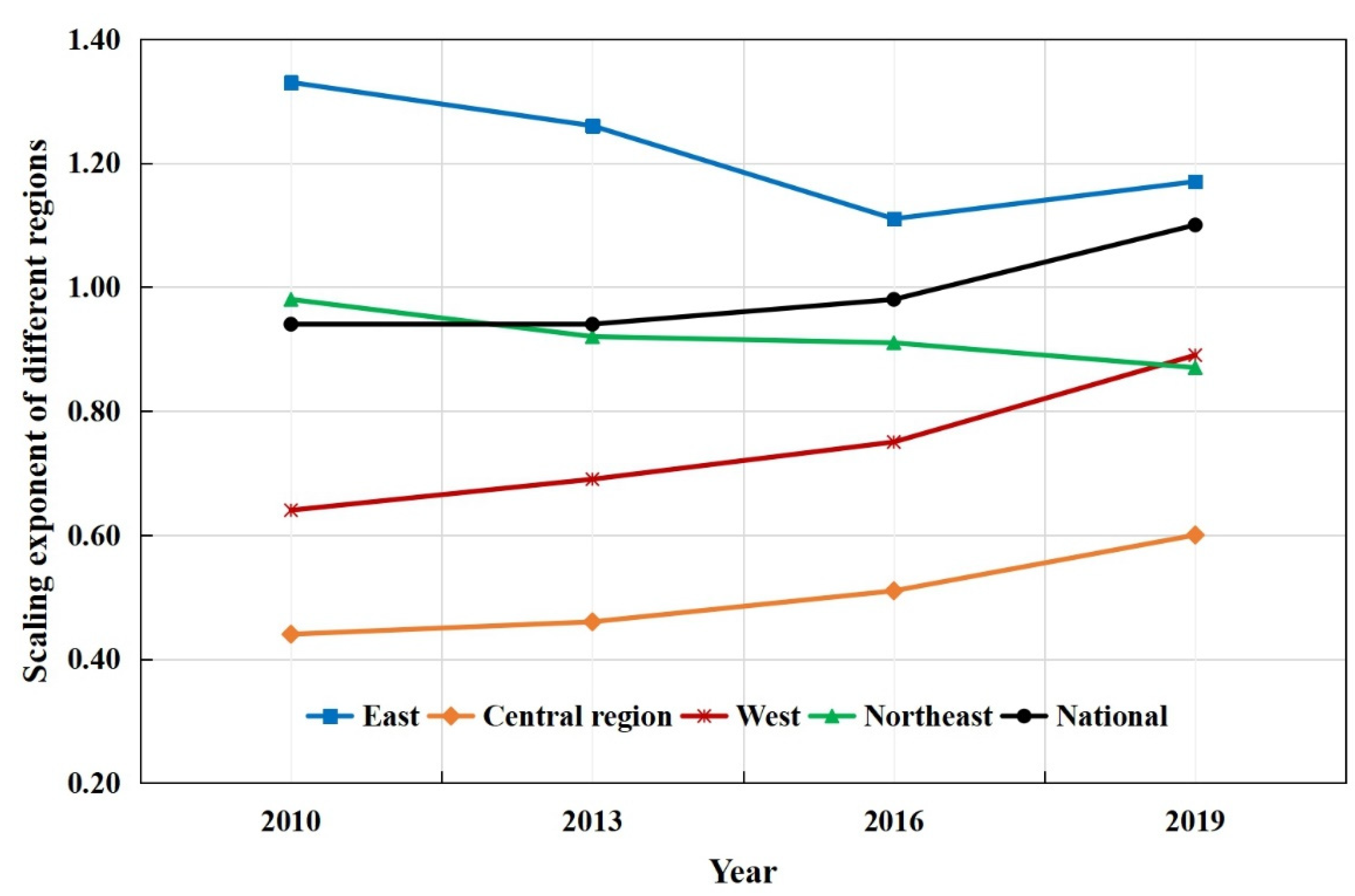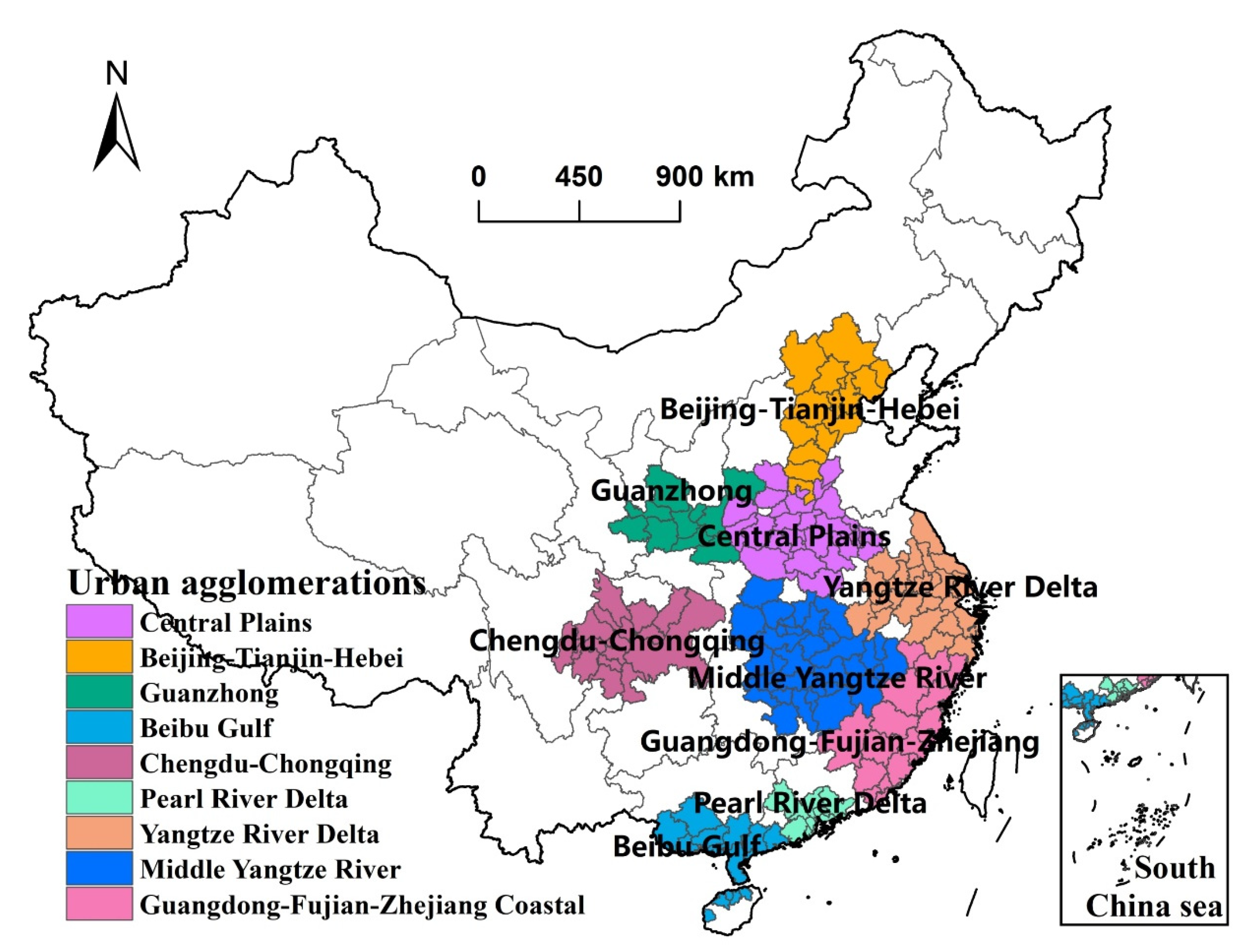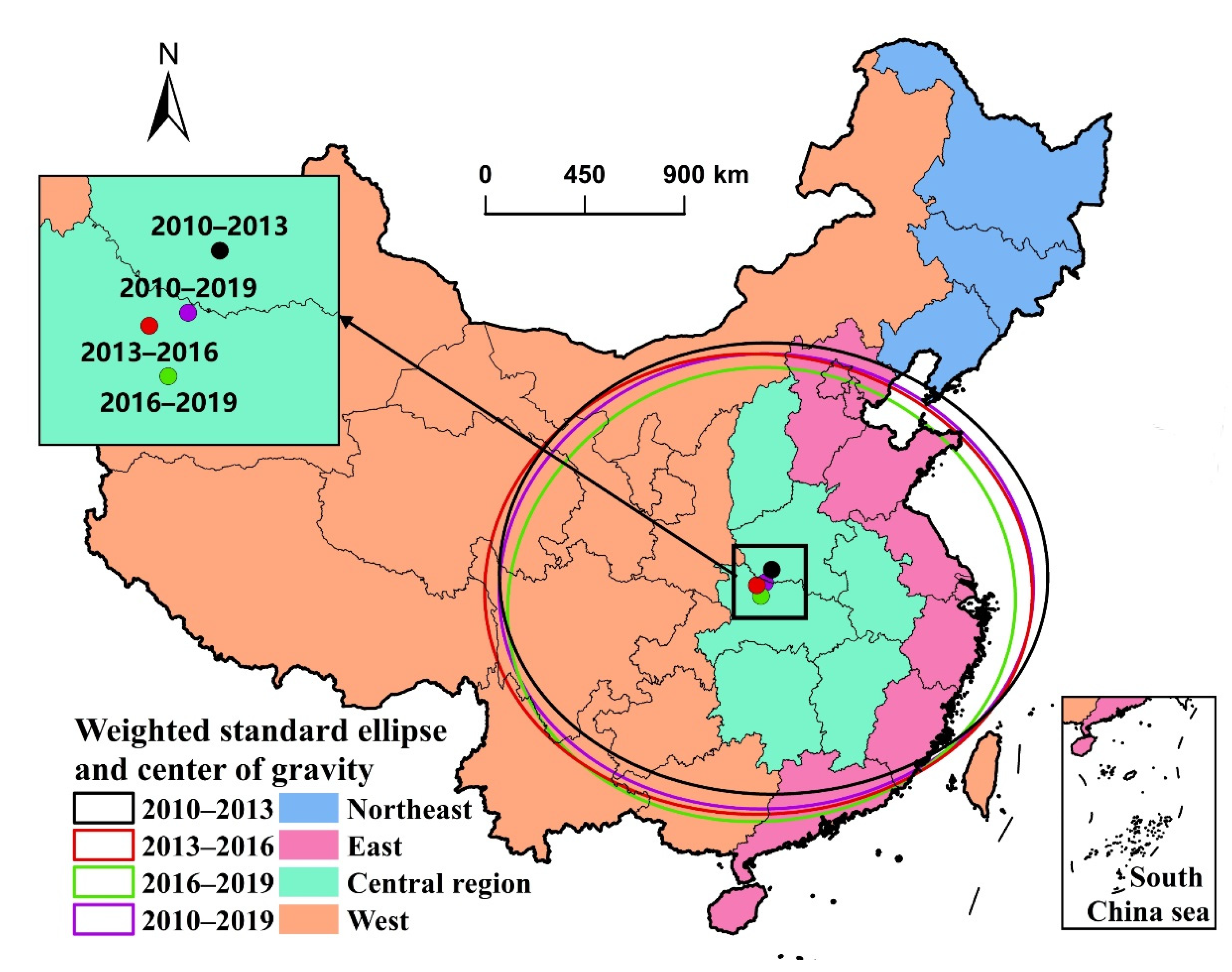The Industrial Sprawl in China from 2010 to 2019: A Multi-Level Spatial Analysis Based on Urban Scaling Law
Abstract
:1. Introduction
2. Materials and Methods
2.1. Study Area and Data Sources
2.2. Methods
2.2.1. SAMI of Urban Scaling Law
2.2.2. Kernel Density Estimation
2.2.3. Cold–Hot Spot Analysis
2.2.4. Weighted Standard Deviation Ellipse
3. Results
3.1. Regional Difference of Industrial Sprawl
3.2. Difference of Urban Agglomerations of Industrial Sprawl
3.3. Urban Difference of Industrial Sprawl
3.4. Direction, Gravity Center, and Range Evolution of Industrial Sprawl
4. Discussion
5. Conclusions
Author Contributions
Funding
Institutional Review Board Statement
Informed Consent Statement
Data Availability Statement
Conflicts of Interest
References
- Chen, Y.; Liu, Z.; Zhou, B. Population-environment dynamics across world’s top 100 urban agglomerations: With implications for transitioning toward global urban sustainability. J. Environ. Manag. 2022, 319, 115630. [Google Scholar] [CrossRef] [PubMed]
- Li, G.; Sun, S.; Fang, C. The varying driving forces of urban expansion in China: Insights from a spatial-temporal analysis. Landsc. Urban Plan. 2018, 174, 63–77. [Google Scholar] [CrossRef]
- Liu, X.; Zou, Z. Analysis on urban scaling characteristics of China’s relatively developed cities. PLoS ONE 2020, 15, e236593. [Google Scholar] [CrossRef] [PubMed]
- Wei, Y.; Li, H.; Yue, W. Urban land expansion and regional inequality in transitional China. Landsc. Urban Plan. 2017, 163, 17–31. [Google Scholar] [CrossRef]
- Dong, H.; Xue, M.; Xiao, Y.; Liu, Y. Do carbon emissions impact the health of residents? Considering China’s industrialization and urbanization. Sci. Total Environ. 2021, 758, 143688. [Google Scholar] [CrossRef]
- Li, Q.; Chen, W.; Li, M.; Yu, Q.; Wang, Y. Identifying the effects of industrial land expansion on PM2.5 concentrations: A spatiotemporal analysis in China. Ecol. Indic. 2022, 141, 109069. [Google Scholar] [CrossRef]
- Choy, L.; Lai, Y.; Lok, W. Economic performance of industrial development on collective land in the urbanization process in China: Empirical evidence from Shenzhen. Habitat Int. 2013, 40, 184–193. [Google Scholar] [CrossRef]
- Chen, W.; He, R.; Wu, Q. A novel efficiency measure model for industrial land use based on subvector data envelope analysis and spatial analysis method. Complexity 2017, 2017, 9516267. [Google Scholar] [CrossRef] [Green Version]
- Yang, Y.; Jiang, G.; Zheng, Q.; Zhou, D.; Li, Y. Does the land use structure change conform to the evolution law of industrial structure? An empirical study of Anhui Province, China. Land Use Policy 2019, 81, 657–667. [Google Scholar]
- Liu, Y. Introduction to land use and rural sustainability in China. Land Use Policy 2018, 74, 1–4. [Google Scholar] [CrossRef]
- Lu, S.; Wang, H. Local economic structure, regional competition and the formation of industrial land price in China: Combining evidence from process tracing with quantitative results. Land Use Policy 2020, 97, 104704. [Google Scholar] [CrossRef]
- He, Q.; Xu, M.; Xu, Z.; Ye, Y.; Shu, X.; Xie, P.; Wu, J. Promotion incentives, infrastructure construction, and industrial landscapes in China. Land Use Policy 2019, 87, 104101. [Google Scholar] [CrossRef]
- Kuang, W.; Liu, J.; Dong, J.; Chi, W.; Zhang, C. The rapid and massive urban and industrial land expansions in China between 1990 and 2010: A CLUD-based analysis of their trajectories, patterns, and drivers. Landsc. Urban Plan. 2016, 145, 21–33. [Google Scholar] [CrossRef]
- Kang, L.; Ma, L. Expansion of industrial parks in the Beijing-Tianjin-Hebei Urban Agglomeration: A spatial analysis. Land 2021, 10, 1118. [Google Scholar] [CrossRef]
- Huang, Z.; He, C.; Li, H. Local government intervention, firm-government connection, and industrial land expansion in China. J. Urban Aff. 2019, 41, 206–222. [Google Scholar] [CrossRef]
- Chen, W.; Ning, S.; Chen, W.; Liu, E.N.; Wang, Y.; Zhao, M. Spatial-temporal characteristics of industrial land green efficiency in China: Evidence from prefecture-level cities. Ecol. Indic. 2020, 113, 106256. [Google Scholar] [CrossRef]
- Tu, F.; Yu, X.; Ruan, J. Industrial land use efficiency under government intervention: Evidence from Hangzhou, China. Habitat Int. 2014, 43, 1–10. [Google Scholar] [CrossRef]
- Zhang, C.; Kuang, W.; Wu, J.; Liu, J.; Tian, H. Industrial land expansion in rural China threatens environmental securities. Front. Environ. Sci. Eng. 2021, 15, 299–319. [Google Scholar] [CrossRef]
- Liu, Y.; Fan, P.; Yue, W.; Song, Y. Impacts of land finance on urban sprawl in China: The case of Chongqing. Land Use Policy 2018, 72, 420–432. [Google Scholar] [CrossRef]
- Kuang, B.; Lu, X.; Zhou, M.; Chen, D. Provincial cultivated land use efficiency in China: Empirical analysis based on the SBM-DEA model with carbon emissions considered. Technol. Forecast. Soc. Change 2020, 151, 119874. [Google Scholar] [CrossRef]
- Zhang, W.; Wang, B.; Wang, J.; Wu, Q.; Wei, Y.D. How does industrial agglomeration affect urban land use efficiency? A spatial analysis of Chinese cities. Land Use Policy 2022, 119, 106178. [Google Scholar] [CrossRef]
- Zeng, C.; Zhang, M.; Cui, J.; He, S. Monitoring and modeling urban expansion—A spatially explicit and multi-scale perspective. Cities 2015, 43, 92–103. [Google Scholar] [CrossRef]
- Parnell, S. Defining a global urban development agenda. World Dev. 2016, 78, 529–540. [Google Scholar] [CrossRef]
- Oueslati, W.; Alvanides, S.; Garrod, G. Determinants of urban sprawl in European cities. Urban Stud. 2015, 52, 1594–1614. [Google Scholar] [CrossRef] [PubMed] [Green Version]
- Kabiraj, S. Spatial expansion of industrial area and its impact on environmental indicators—A case study in West Bengal. Arab. J. Geosci. 2021, 14, e1159. [Google Scholar] [CrossRef]
- Park, J.; Kim, J. Does industrial land sprawl matter in land productivity? A case study of industrial parks of South Korea. J. Clean. Prod. 2022, 334, 130209. [Google Scholar] [CrossRef]
- Pu, W.; Zhang, A. Can market reforms curb the expansion of industrial land?—Based on the panel data analysis of five national-level urban agglomerations. Sustainability 2021, 13, 4472. [Google Scholar] [CrossRef]
- Zhang, L.; Yue, W.; Liu, Y.; Fan, P.; Wei, Y.D. Suburban industrial land development in transitional China: Spatial restructuring and determinants. Cities 2018, 78, 96–107. [Google Scholar] [CrossRef]
- Lang, W.; Long, Y.; Chen, T.; Li, X. Reinvestigating China’s urbanization through the lens of allometric scaling. Phys. A Stat. Mech. Its Appl. 2019, 525, 1429–1439. [Google Scholar] [CrossRef]
- Bettencourt, L.M.; Lobo, J.; Helbing, D.; Kühnert, C.; West, G.B. Growth, innovation, scaling, and the pace of life in cities. Proc. Natl. Acad. Sci. USA 2007, 104, 7301–7306. [Google Scholar] [CrossRef] [Green Version]
- Arcaute, E.; Hatna, E.; Ferguson, P.; Youn, H.; Johansson, A.; Batty, M. Constructing cities, deconstructing scaling laws. J. R. Soc. Interface 2015, 12, 20140745. [Google Scholar] [CrossRef]
- Meirelles, J.; Neto, C.R.; Ferreira, F.F.; Ribeiro, F.L.; Binder, C.R. Evolution of urban scaling: Evidence from Brazil. PLoS ONE 2018, 13, e204574. [Google Scholar] [CrossRef] [PubMed] [Green Version]
- Van Raan, A.F.J.; Van der Meulen, G.; Goedhart, W. Urban scaling of cities in the Netherlands. PLoS ONE 2016, 11, e146775. [Google Scholar] [CrossRef] [PubMed] [Green Version]
- Cesaretti, R.; Lobo, J.; Bettencourt, L.M.; Ortman, S.G.; Smith, M.E. Population-area relationship for Medieval European cities. PLoS ONE 2016, 11, e162678. [Google Scholar] [CrossRef] [PubMed] [Green Version]
- Ortman, S.G.; Cabaniss, A.H.; Sturm, J.O.; Bettencourt, L.M. The pre-history of urban scaling. PLoS ONE 2014, 9, e87902. [Google Scholar] [CrossRef]
- Jiao, L.; Xu, Z.; Xu, G.; Zhao, R.; Liu, J.; Wang, W. Assessment of urban land use efficiency in China: A perspective of scaling law. Habitat Int. 2020, 99, 102172. [Google Scholar] [CrossRef]
- Xu, G.; Xu, Z.; Gu, Y.; Lei, W.; Pan, Y.; Liu, J.; Jiao, L. Scaling laws in intra-urban systems and over time at the district level in Shanghai, China. Phys. A-Stat. Mech. Its Appl. 2020, 560, 125162. [Google Scholar] [CrossRef]
- Bettencourt, L.M.A. The origins of scaling in cities. Science 2013, 340, 1438–1441. [Google Scholar] [CrossRef] [Green Version]
- Bettencourt, L.M.; Lobo, J.; Strumsky, D.; West, G.B. Urban scaling and its deviations: Revealing the structure of wealth, innovation and crime across cities. PLoS ONE 2010, 5, e13541. [Google Scholar] [CrossRef] [Green Version]
- Yang, T.; Zhou, K.; Zhang, C. Spatiotemporal patterns and influencing factors of green development efficiency in China’s urban agglomerations. Sustain. Cities Soc. 2022, 85, 104069. [Google Scholar] [CrossRef]
- Guan, X.; Wang, W.; Cai, Y. Spatiotemporal dynamics of a Leslie-Gower predator-prey model incorporating a prey refuge. Nonlinear Anal.-Real World Appl. 2011, 12, 2385–2395. [Google Scholar] [CrossRef]
- Fu, W.; Zhou, Y. Based on ARCGIS-SDE spatial evolution trend of industrial clusters space. Appl. Mech. Mater. 2015, 733, 982–985. [Google Scholar] [CrossRef]
- Zhang, M.; Tan, S.; Zhang, X. How do varying socio-economic factors affect the scale of land transfer? Evidence from 287 cities in China. Environ. Sci. Pollut. Res. 2022, 29, 40865–40877. [Google Scholar] [CrossRef]
- Zhang, M.; Zhang, C.; Kafy, A.A.; Tan, S. Simulating the relationship between land use/cover change and urban thermal environment using machine learning algorithms in Wuhan city, China. Land 2021, 11, 14. [Google Scholar] [CrossRef]
- Yang, S.; Hu, S.; Li, W.; Zhang, C.; Song, D. Spatio-temporal nonstationary effects of impact factors on industrial land price in industrializing cities of China. Sustainability 2020, 12, 2792. [Google Scholar] [CrossRef] [Green Version]
- Xu, G.; Geng, M.; Schwarz, P.; Dong, H.; Gong, Y.; Yang, H.; Thomas, M. The effect of industrial relocations to central and western China on urban construction land expansion. J. Land Use Sci. 2021, 16, 339–357. [Google Scholar] [CrossRef]
- Zhang, T.; Song, Y.; Yang, J. Relationships between urbanization and CO2 emissions in China: An empirical analysis of population migration. PLoS ONE 2021, 16, e256335. [Google Scholar] [CrossRef] [PubMed]
- Bai, X.; Shi, P.; Liu, Y. Society: Realizing China’s urban dream. Nature 2014, 509, 158–160. [Google Scholar] [CrossRef] [Green Version]
- Zhang, M.; Tan, S.; Pan, Z.; Hao, D.; Zhang, X.; Chen, Z. The spatial spillover effect and nonlinear relationship analysis between land resource misallocation and environmental pollution: Evidence from China. J. Environ. Manag. 2022, 321, 115873. [Google Scholar] [CrossRef]
- Xie, H.; Zhai, Q.; Wang, W.; Yu, J.; Lu, F.; Chen, Q. Does intensive land use promote a reduction in carbon emissions? Evidence from the Chinese industrial sector. Resour. Conserv. Recycl. 2018, 137, 167–176. [Google Scholar] [CrossRef]
- Wu, F. Planning centrality, market instruments: Governing Chinese urban transformation under state entrepreneurialism. Urban Stud. 2018, 55, 1383–1399. [Google Scholar] [CrossRef]
- Zhang, M.; Kafy, A.A.; Ren, B.; Zhang, Y.; Tan, S.; Li, J. Application of the optimal parameter geographic detector model in the identification of influencing factors of ecological quality in Guangzhou, China. Land 2022, 11, 1303. [Google Scholar] [CrossRef]
- Zhang, M.; Kafy, A.A.; Xiao, P.; Han, S.; Zou, S.; Saha, M.; Zhang, C.; Tan, S. Impact of urban expansion on land surface temperature and carbon emissions using machine learning algorithms in Wuhan, China. Urban Clim. 2023, 47, 101347. [Google Scholar] [CrossRef]






| Region | Industrial Land Area (Unit: km2) | Growth Rate of Industrial Land | ||||||
|---|---|---|---|---|---|---|---|---|
| 2010 | 2013 | 2016 | 2019 | 2010–2013 | 2013–2016 | 2016–2019 | 2010–2019 | |
| East | 4338.77 | 4635.52 | 5572.06 | 5913.99 | 6.84% | 20.20% | 6.14% | 36.31% |
| Central region | 1703.36 | 1777.67 | 1812.56 | 2146.49 | 4.36% | 1.96% | 18.42% | 26.02% |
| West | 1558.94 | 1583.71 | 1796.67 | 2025.92 | 1.59% | 13.45% | 12.76% | 29.95% |
| Northeast | 1088.42 | 1152.68 | 1343.95 | 1365.46 | 5.90% | 16.59% | 1.60% | 25.45% |
| National scale | 8689.49 | 9149.58 | 10,525.24 | 11,451.86 | 5.29% | 15.04% | 8.80% | 31.79% |
| Urban Agglomeration | 2010 | 2013 | 2016 | 2019 |
|---|---|---|---|---|
| Beijing-Tianjin-Hebei | 1.68 | 1.63 | 1.45 | 1.78 |
| Yangtze River Delta | 1.11 | 1.24 | 1.38 | 1.29 |
| Pearl River Delta | 0.95 | 1.38 | 0.84 | 0.79 |
| Chengdu-Chongqing | 1.4 | 1.37 | 1.24 | 1.25 |
| Middle Yangtze River | 0.62 | 0.53 | 0.51 | 0.74 |
| Central Plains | 0.29 | 0.41 | 0.52 | 0.4 |
| Guanzhong | 1.15 | 1.27 | 1.00 | 1.15 |
| Beibu Gulf | 1.01 | 1.00 | 0.76 | 0.51 |
| Guangdong-Fujian-Zhejiang | 0.45 | 0.11 | 0.18 | 0.24 |
| Year | X StdDist | Y StdDist | Area | Azimuth Angle | Center X | Center Y |
|---|---|---|---|---|---|---|
| 2010–2013 | 13.43 | 9.10 | 383.92 | 92.69 | 112.31 | 32.89 |
| 2013–2016 | 13.32 | 9.29 | 388.56 | 92.15 | 111.53 | 32.30 |
| 2016–2019 | 12.30 | 9.14 | 353.42 | 89.13 | 111.70 | 31.87 |
| 2010–2019 | 13.01 | 9.17 | 375.03 | 91.18 | 111.94 | 32.39 |
Publisher’s Note: MDPI stays neutral with regard to jurisdictional claims in published maps and institutional affiliations. |
© 2022 by the authors. Licensee MDPI, Basel, Switzerland. This article is an open access article distributed under the terms and conditions of the Creative Commons Attribution (CC BY) license (https://creativecommons.org/licenses/by/4.0/).
Share and Cite
Zhang, L.; Lin, X.; Qiu, B.; Zhang, M.; He, Q. The Industrial Sprawl in China from 2010 to 2019: A Multi-Level Spatial Analysis Based on Urban Scaling Law. Int. J. Environ. Res. Public Health 2022, 19, 16255. https://doi.org/10.3390/ijerph192316255
Zhang L, Lin X, Qiu B, Zhang M, He Q. The Industrial Sprawl in China from 2010 to 2019: A Multi-Level Spatial Analysis Based on Urban Scaling Law. International Journal of Environmental Research and Public Health. 2022; 19(23):16255. https://doi.org/10.3390/ijerph192316255
Chicago/Turabian StyleZhang, Lu, Xuehan Lin, Bingkui Qiu, Maomao Zhang, and Qingsong He. 2022. "The Industrial Sprawl in China from 2010 to 2019: A Multi-Level Spatial Analysis Based on Urban Scaling Law" International Journal of Environmental Research and Public Health 19, no. 23: 16255. https://doi.org/10.3390/ijerph192316255






